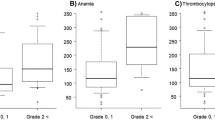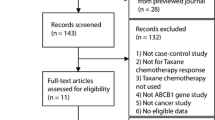Abstract
We have previously reported an association between ABCB1 C3435T polymorphism and docetaxel pharmacokinetics in breast cancer patients. We therefore investigated whether these parameters could account for variations in pathological response. Five ABCB1 polymorphisms including C3435T polymorphism were analyzed in breast cancer patients receiving neoadjuvant chemotherapy with doxorubicin and docetaxel (n = 101). Pathological response was assessed using the Sataloff classification. Pharmacokinetic analysis was performed for the first course of docetaxel (n = 84). No significant association was found between ABCB1 polymorphisms or docetaxel pharmacokinetics and pathological complete response. C3435T genotype was an independent predictive factor of good response in breast (response >50 %, i.e., Sataloff T-A and T-B): OR: 4.6 (95 % CI: 1.3–16.1), p = 0.015, for TT patients versus CT and CC patients. Area under the plasma concentration–time curve (AUC) of docetaxel was the only independent predictive factor of the total absence of response in breast (Sataloff T-D): OR: 14.3, (95 % CI: 1.7–118), p = 0.015, for AUC of docetaxel <3,500 μg h/L versus ≥3,500 μg h/L. These results suggest that C3435T polymorphism and docetaxel exposure are involved in the response to neoadjuvant chemotherapy in breast cancer patients and may be useful to optimize individualized therapy.

Similar content being viewed by others
References
Bonadonna G, Veronesi U, Brambilla C et al (1990) Primary chemotherapy to avoid mastectomy in tumors with diameters of three centimeters or more. J Natl Cancer Inst 82:1539–1545
van der Hage JA, van de Velde CJ, Julien JP et al (2001) Preoperative chemotherapy in primary operable breast cancer: results from the European Organization for Research and Treatment of Cancer trial 10902. J Clin Oncol 19:4224–4237
Kaufmann M, Morrow M, von Minckwitz G et al (2010) Locoregional treatment of primary breast cancer: consensus recommendations from an International Expert Panel. Cancer 116:1184–1191
Rouzier R, Mathieu MC, Sideris L et al (2004) Breast-conserving surgery after neoadjuvant anthracycline-based chemotherapy for large breast tumors. Cancer 101:918–925
Rouzier R, Pusztai L, Delaloge S et al (2005) Nomograms to predict pathologic complete response and metastasis-free survival after preoperative chemotherapy for breast cancer. J Clin Oncol 23:8331–8339
Gottesman MM, Fojo T, Bates SE (2002) Multidrug resistance in cancer: role of ATP-dependent transporters. Nat Rev Cancer 2:48–58
Schinkel AH (1997) The physiological function of drug-transporting P-glycoproteins. Semin Cancer Biol 8:161–170
Fajac A, Gligorov J, Rezai K et al (2010) Effect of ABCB1 C3435T polymorphism on docetaxel pharmacokinetics according to menopausal status in breast cancer patients. Br J Cancer 103:560–566
Sataloff DM, Mason BA, Prestipino AJ et al (1995) Pathologic response to induction chemotherapy in locally advanced carcinoma of the breast: a determinant of outcome. J Am Coll Surg 180:297–306
Sauter G, Lee J, Bartlett JM et al (2009) Guidelines for human epidermal growth factor receptor 2 testing: biologic and methodologic considerations. J Clin Oncol 27:1323–1333
Baille P, Bruno R, Schellens JH et al (1997) Optimal sampling strategies for bayesian estimation of docetaxel (Taxotere) clearance. Clin Cancer Res 3:1535–1538
Vergniol JC, Bruno R, Montay G et al (1992) Determination of Taxotere in human plasma by a semi-automated high-performance liquid chromatographic method. J Chromatogr 582:273–278
Bruno R, Hille D, Riva A et al (1998) Population pharmacokinetics/pharmacodynamics of docetaxel in phase II studies in patients with cancer. J Clin Oncol 16:187–196
Beal SL, Sheiner LB (1998) NONMEM user’s guide. NONMEM project group, San Francisco
Kuerer HM, Newman LA, Smith TL et al (1999) Clinical course of breast cancer patients with complete pathologic primary tumor and axillary lymph node response to doxorubicin-based neoadjuvant chemotherapy. J Clin Oncol 17:460–469
Harvey V, Mouridsen H, Semiglazov V et al (2006) Phase III trial comparing three doses of docetaxel for second-line treatment of advanced breast cancer. J Clin Oncol 24:4963–4970
Wang LG, Liu XM, Kreis W et al (1999) The effect of antimicrotubule agents on signal transduction pathways of apoptosis: a review. Cancer Chemother Pharmacol 44:355–361
Goncalves A, Viret F, Ciccolini J et al (2003) Phase I and pharmacokinetic study of escalating dose of docetaxel administered with granulocyte colony-stimulating factor support in adult advanced solid tumors. Clin Cancer Res 9:102–108
Seibel NL, Blaney SM, O’Brien M et al (1999) Phase I trial of docetaxel with filgrastim support in pediatric patients with refractory solid tumors: a collaborative Pediatric Oncology Branch, National Cancer Institute and Children’s Cancer Group trial. Clin Cancer Res 5:733–737
Fellay J, Marzolini C, Meaden ER et al (2002) Response to antiretroviral treatment in HIV-1-infected individuals with allelic variants of the multidrug resistance transporter 1: a pharmacogenetics study. Lancet 359:30–36
Hitzl M, Drescher S, van der Kuip H et al (2001) The C3435T mutation in the human MDR1 gene is associated with altered efflux of the P-glycoprotein substrate rhodamine 123 from CD56 + natural killer cells. Pharmacogenetics 11:293–298
Hoffmeyer S, Burk O, von Richter O et al (2000) Functional polymorphisms of the human multidrug-resistance gene: multiple sequence variations and correlation of one allele with P-glycoprotein expression and activity in vivo. Proc Natl Acad Sci USA 97:3473–3478
Tanabe M, Ieiri I, Nagata N et al (2001) Expression of P-glycoprotein in human placenta: relation to genetic polymorphism of the multidrug resistance (MDR)-1 gene. J Pharmacol Exp Ther 297:1137–1143
Vaclavikova R, Nordgard SH, Alnaes GI et al (2008) Single nucleotide polymorphisms in the multidrug resistance gene 1 (ABCB1): effects on its expression and clinicopathological characteristics in breast cancer patients. Pharmacogenet Genomics 18:263–273
Cizmarikova M, Wagnerova M, Schonova L et al (2010) MDR1 (C3435T) polymorphism: relation to the risk of breast cancer and therapeutic outcome. Pharmacogenomics J 10:62–69
George J, Dharanipragada K, Krishnamachari S et al (2009) A single-nucleotide polymorphism in the MDR1 gene as a predictor of response to neoadjuvant chemotherapy in breast cancer. Clin Breast Cancer 9:161–165
Kafka A, Sauer G, Jaeger C et al (2003) Polymorphism C3435T of the MDR-1 gene predicts response to preoperative chemotherapy in locally advanced breast cancer. Int J Oncol 22:1117–1121
Kelly RJ, Draper D, Chen CC et al (2011) A pharmacodynamic study of docetaxel in combination with the P-glycoprotein antagonist tariquidar (XR9576) in patients with lung, ovarian, and cervical cancer. Clin Cancer Res 17:569–580
Acknowledgments
The authors would like to thank Assistance Publique-Hôpitaux de Paris and ACTT (Amis du Centre des Tumeurs de Tenon) association for financial support, URC-Est for help in the design of this study, and Jean-Pierre Lotz, Florent Soubrier and Serge Uzan for their constant support. This study was supported by Assistance Publique-Hôpitaux de Paris (Grant Number PHRC AOR03015) and ACTT (Amis du Centre des Tumeurs de Tenon) association.
Conflict of interest
The authors declare that they have no conflict of interest.
Author information
Authors and Affiliations
Corresponding author
Additional information
Joseph Gligorov & Pierre Lévy are the first co-authors. Anne Fajac, Pierre Lévy & Joseph Gligorov equally contributed to the study.
Electronic supplementary material
Below is the link to the electronic supplementary material.
Rights and permissions
About this article
Cite this article
Lévy, P., Gligorov, J., Antoine, M. et al. Influence of ABCB1 polymorphisms and docetaxel pharmacokinetics on pathological response to neoadjuvant chemotherapy in breast cancer patients. Breast Cancer Res Treat 139, 421–428 (2013). https://doi.org/10.1007/s10549-013-2545-7
Received:
Accepted:
Published:
Issue Date:
DOI: https://doi.org/10.1007/s10549-013-2545-7




